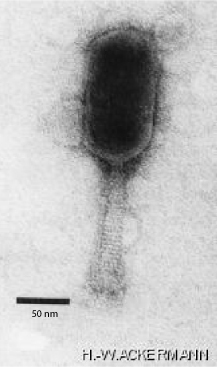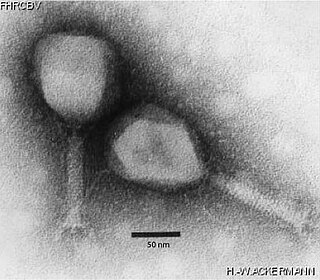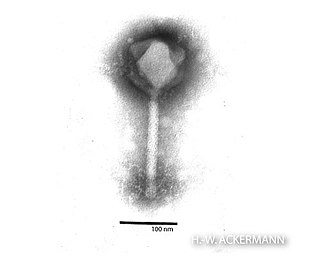
Podoviridae was a family of bacteriophage in the order Caudovirales often associated with T-7 like phages. The family and order Caudoviraleshave now been abolished, with the term podovirus now used to refer to the morphology of viruses in this former family. There were 130 species in this family, assigned to 3 subfamilies and 52 genera. This family was characterized by having very short, noncontractile tails. Many former phages in the former family Podoviriade are now classified in the Autographiviridae

Caudoviricetes is a class of viruses known as the tailed bacteriophages. Under the Baltimore classification scheme, the Caudoviricetes are group I viruses as they have double stranded DNA (dsDNA) genomes, which can be anywhere from 18,000 base pairs to 500,000 base pairs in length. The virus particles have a distinct shape; each virion has an icosahedral head that contains the viral genome, and is attached to a flexible tail by a connector protein. The order encompasses a wide range of viruses, many containing genes of similar nucleotide sequence and function. However, some tailed bacteriophage genomes can vary quite significantly in nucleotide sequence, even among the same genus. Due to their characteristic structure and possession of potentially homologous genes, it is believed these bacteriophages possess a common origin.

Cyanophages are viruses that infect cyanobacteria, also known as Cyanophyta or blue-green algae. Cyanobacteria are a phylum of bacteria that obtain their energy through the process of photosynthesis. Although cyanobacteria metabolize photoautotrophically like eukaryotic plants, they have prokaryotic cell structure. Cyanophages can be found in both freshwater and marine environments. Marine and freshwater cyanophages have icosahedral heads, which contain double-stranded DNA, attached to a tail by connector proteins. The size of the head and tail vary among species of cyanophages. Cyanophages infect a wide range of cyanobacteria and are key regulators of the cyanobacterial populations in aquatic environments, and may aid in the prevention of cyanobacterial blooms in freshwater and marine ecosystems. These blooms can pose a danger to humans and other animals, particularly in eutrophic freshwater lakes. Infection by these viruses is highly prevalent in cells belonging to Synechococcus spp. in marine environments, where up to 5% of cells belonging to marine cyanobacterial cells have been reported to contain mature phage particles.
Punavirus is a genus of viruses in the order Caudovirales, in the family Myoviridae. Bacteria serve as natural hosts. There are four species in this genus.
Hpunavirus is a genus of viruses in the family Myoviridae, within the subfamily Peduovirinae. Bacteria serve as the natural host, with transmission achieved through passive diffusion. There are two species in this genus.
Peduovirus is a genus of viruses in the order Caudovirales, in the family Myoviridae, in the subfamily Peduovirinae. Bacteria serve as natural hosts, with transmission achieved through passive diffusion. There are 15 species in this genus.
Twortvirus is a genus of viruses in the order Caudovirales, in the family Herelleviridae, in the subfamily Twortvirinae. Bacteria serve as natural hosts. There is only one species in this genus: Staphylococcus virus Twort.

Schizotequatrovirus is a unassigned genus of viruses in the unassigned family Straboviridae, in the class Caudoviricetes,. Bacteria serve as natural hosts. There are three species in this genus.
Tequatrovirus is a genus of viruses in the order Caudovirales, in the family Myoviridae, in the subfamily Tevenvirinae. Gram-negative bacteria serve as the natural host, with transmission achieved through passive diffusion. There are 75 species in this genus.
Peduovirinae is a subfamily of viruses in the order Caudovirales, in the family Myoviridae. Bacteria serve as natural hosts. There are 76 species in this subfamily, assigned to 31 genera.
Felixounavirus is a genus of viruses in the order Caudovirales, in the family Myoviridae. Bacteria serve as natural hosts, with transmission achieved through passive diffusion. There are currently 16 species in this genus, including the type species Salmonella virus FelixO1.

Tevenvirinae is a subfamily of viruses in the order Caudovirales, in the family Myoviridae. Bacteria and archaea serve as natural hosts. There are 135 species in this subfamily, most included in 12 genera.
Hapunavirus is a genus of viruses in the family Myoviridae, not assigned to a subfamily. Bacteria serve as the natural host, with transmission achieved through passive diffusion. There are two species in this genus.
Muvirus is a genus of viruses in the order Caudovirales, in the family Myoviridae. Bacteria serve as natural hosts, with transmission achieved through passive diffusion. There are two species in this genus.
Lubbockvirus is a genus of viruses in the family Myoviridae, not assigned to a subfamily. Bacteria serve as the natural host, with transmission achieved through passive diffusion. There are two species in this genus.
Myohalovirus is a genus of viruses in the order Caudovirales, in the family Myoviridae. Bacteria and archaea serve as natural hosts. There are three species in this genus.

Phikzvirus is a genus of viruses in the order Caudovirales, in the family Myoviridae. Bacteria serve as natural hosts. There are three species in this genus.

Teseptimavirus is a genus of viruses in the order Caudovirales, in the family Autographiviridae, in the subfamily Studiervirinae. Bacteria serve as the natural host, with transmission achieved through passive diffusion. There are currently 17 species in this genus, including the type species Escherichia virus T7.
Mycobacterium virus D29 (D29) is a cluster A mycobacteriophage belonging to the Siphoviridae family of viruses, it was discovered in 1954 by S. Froman. D29 is notable for its ability to infect M. tuberculosis. D29 is a double stranded DNA mycobacteriophage. It is a lytic phage, this means that D29 takes the lytic pathway of infection instead of the lysogenic pathway of infection. There are no human associated diseases associated with mycobacterium virus D29.
Escherichia virus CC31, formerly known as Enterobacter virus CC31, is a dsDNA bacteriophage of the subfamily Tevenvirinae responsible for infecting the bacteria family of Enterobacteriaceae. It is one of two discovered viruses of the genus Karamvirus, diverging away from the previously discovered T4virus, as a clonal complex (CC). CC31 was first isolated from Escherichia coli B strain S/6/4 and is primarily associated with Escherichia, even though is named after Enterobacter.










